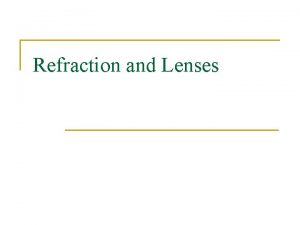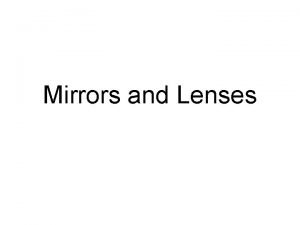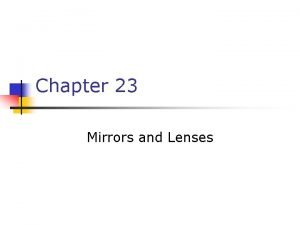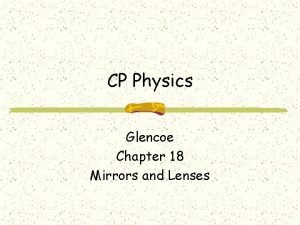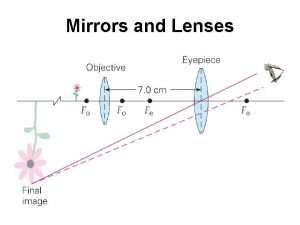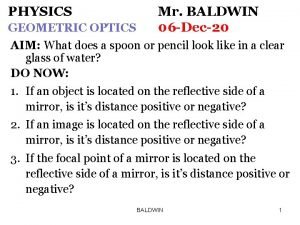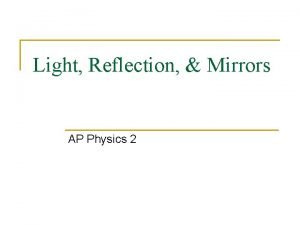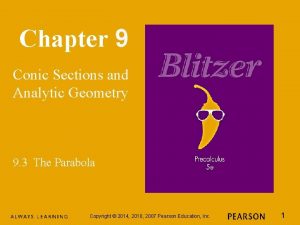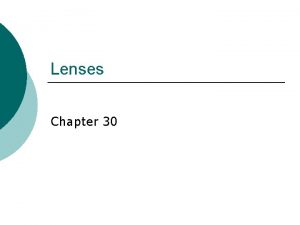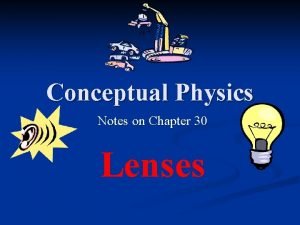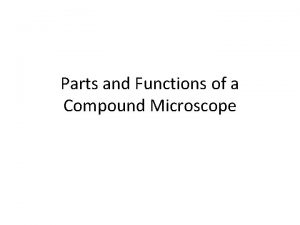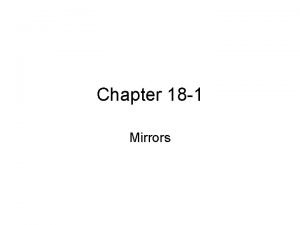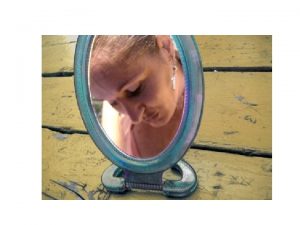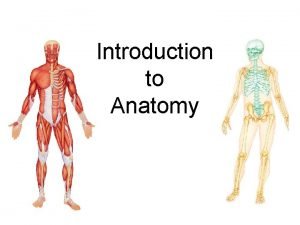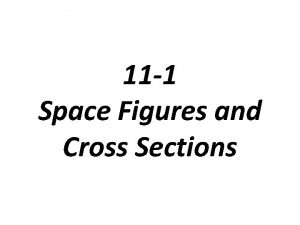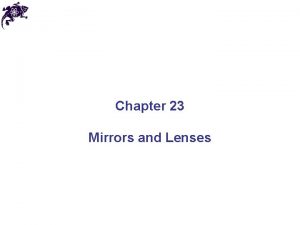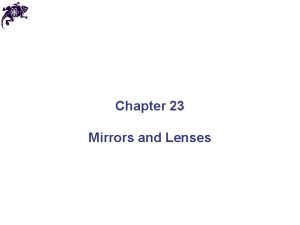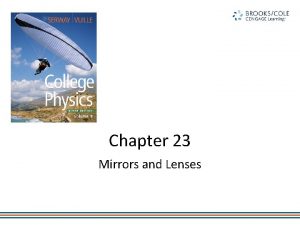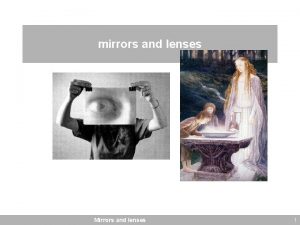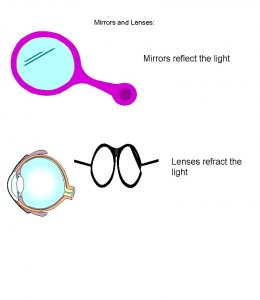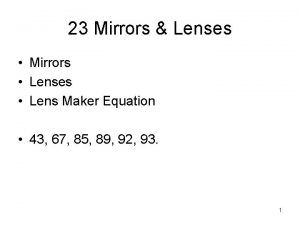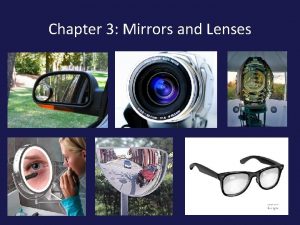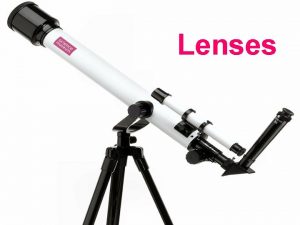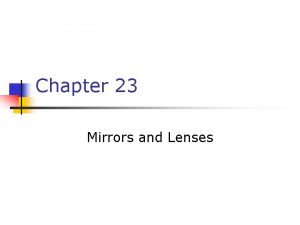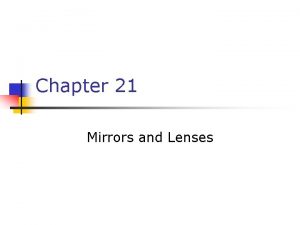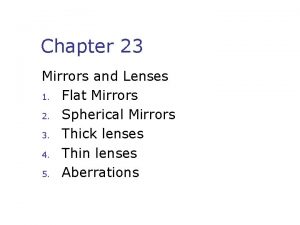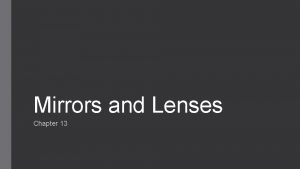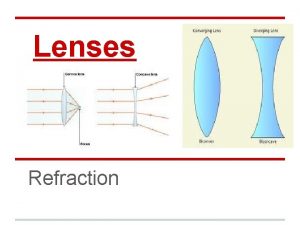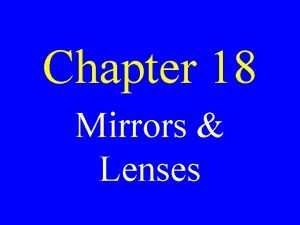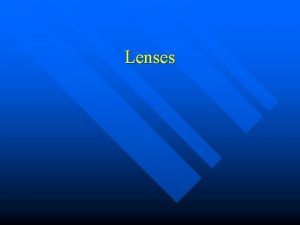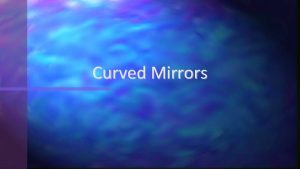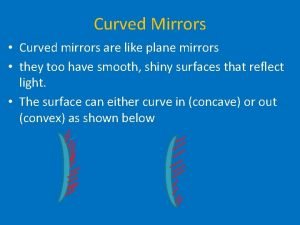Chapter 23 Mirrors and Lenses Mirrors Sections 1






















- Slides: 22

Chapter 23 Mirrors and Lenses

Mirrors Sections 1– 3 General Medical Physics

Notation for Mirrors and Lenses • The object distance is the distance from the object to the mirror or lens – Denoted by p • The image distance is the distance from the image to the mirror or lens – Denoted by q • The lateral magnification of the mirror or lens is the ratio of the image height to the object height – Denoted by M = h’ / h General Medical Physics

Images for Mirrors and Lenses • A real image is one in which light actually passes through the image point – Real images can be displayed on screens • A virtual image is one in which the light does not pass through the image point – The light appears to diverge from that point – Virtual images cannot be displayed on screens • To find where an image is formed, it is always necessary to follow at least two rays of light as they reflect from the mirror or refract through the lens General Medical Physics

Flat (Plane) Mirror • Simplest possible mirror • Properties of the image can be determined by geometry • One ray starts at P, follows path PQ and reflects back on itself • A second ray follows path PR and reflects according to the Law of Reflection General Medical Physics

Flat (Plane) Mirror, cont • The image is as far behind the mirror as the object is in front: q = p • The image is unmagnified: M = 1 since h’ = h • The image is virtual: light rays appears to diverge from behind mirror • The image is upright: it has the same orientation as the object • There is an apparent left-right reversal in the image Active Figure: A Plane Mirror General Medical Physics

Flat (Plane) Mirror, final • An image formed by reflection from a flat mirror • The image (I) is behind the mirror at distance q, which is equal in magnitude to the object (O) distance p General Medical Physics

Application – Day and Night Settings on Auto Mirrors • With the daytime setting, the bright beam of reflected light is directed into the driver’s eyes • With the nighttime setting, the dim beam of reflected light is directed into the driver’s eyes, while the bright beam goes elsewhere General Physics Medical Physics

Spherical Mirrors • A concave spherical mirror has the silvered surface of the mirror on the inner, or concave, side of the curve • A convex spherical mirror has the silvered surface of the mirror on the outer, or convex, side of the curve General Medical Physics

Concave Mirror, Notation • The mirror has a radius of curvature of R • Its center of curvature is the point C • Point V is the center of the spherical segment • A line drawn from C to V is called the principle axis of the mirror General Medical Physics

Image Formed by Concave Mirror • Geometry shows the relationship between the image and object distances – This is called the mirror equation • Geometry can be used to determine the magnification of the image – h’ is negative when the image is inverted with respect to the object General Medical Physics

Focal Point and Focal Length • If an object is very far away, then p = and 1/p = 0 • Incoming rays are essentially parallel • In this special case, the image point is called the focal point • The distance from the mirror to the focal point is called the focal length – The focal length is ½ the radius of curvature: f = ½R General Medical Physics

Focal Point and Focal Length, cont • The focal point is dependent solely on the curvature of the mirror, not by the location of the object • f=R/2 • The mirror equation can be expressed as General Medical Physics

Focal Length Shown by Parallel Rays General Medical Physics

Ray Diagrams • A ray diagram can be used to determine the position and size of an image • They are graphical constructions which tell the overall nature of the image • They can also be used to check the parameters calculated from the mirror and magnification equations General Medical Physics

Drawing A Ray Diagram • To make the ray diagram, you need to know – The position of the object – The position of the center of curvature • Three rays are drawn – They all start from the same position on the object • The intersection of any two of the rays at a point locates the image – The third ray serves as a check of the construction • Ray 1 is drawn parallel to the principle axis and is reflected back through the focal point, F • Ray 2 is drawn through the focal point and is reflected parallel to the principle axis • Ray 3 is drawn through the center of curvature and is reflected back on itself General Medical Physics

Ray Diagram for Concave Mirror, p > R • The object is outside the center of curvature of the mirror • The image is real and inverted • The image is smaller than the object: |M| < 1 General Medical Physics

Ray Diagram for a Concave Mirror, p < f • The object is between the mirror and the focal point • The image is virtual and upright • The image is larger than the object: |M| > 1 Active Figure: Spherical and Parabolic Mirrors General Medical Physics

Sign Conventions for Mirrors General Medical Physics

Convex Mirrors • A convex mirror is sometimes called a diverging mirror • The rays from any point on the object diverge after reflection as though they were coming from some point behind the mirror • The image is virtual because it lies behind the mirror at the point where the reflected rays appear to originate • In general, the image formed by a convex mirror is upright, virtual, and smaller than the object General Medical Physics

Ray Diagram for a Convex Mirror • The object is in front of a convex mirror • The image is virtual and upright • The image is smaller than the object: |M| < 1 Active Figure: Spherical and Parabolic Mirrors General Medical Physics

Notes on Images • With a concave mirror, the image may be either real or virtual – When the object is outside the focal point, the image is real – When the object is at the focal point, the image is infinitely far away – When the object is between the mirror and the focal point, the image is virtual • With a convex mirror, the image is always virtual and upright – As the object distance increases, the virtual image gets smaller General Medical Physics
 Refraction by a lens
Refraction by a lens Mirrors and lenses
Mirrors and lenses Mirrors and lenses
Mirrors and lenses Physics classroom lenses and mirrors
Physics classroom lenses and mirrors Mirror and lens equation
Mirror and lens equation Site:slidetodoc.com
Site:slidetodoc.com Ap physics 2 mirrors and lenses
Ap physics 2 mirrors and lenses Chapter 17 reflection and mirrors
Chapter 17 reflection and mirrors Chapter 9 conic sections and analytic geometry
Chapter 9 conic sections and analytic geometry Chapter 7 conic sections and parametric equations
Chapter 7 conic sections and parametric equations Chapter 9 conic sections and analytic geometry
Chapter 9 conic sections and analytic geometry Chapter 30 lenses
Chapter 30 lenses Chapter 30 lenses
Chapter 30 lenses How many sections are in the chapter handbook for tx hosa?
How many sections are in the chapter handbook for tx hosa? Function compound microscope
Function compound microscope It is flat smooth mirror
It is flat smooth mirror Physics
Physics Cutaways and cross sections definition
Cutaways and cross sections definition Parietal vs visceral
Parietal vs visceral Anatomical positions
Anatomical positions 11-1 space figures and cross sections
11-1 space figures and cross sections Health and safety at work act section 2
Health and safety at work act section 2 Graduated commission examples
Graduated commission examples
